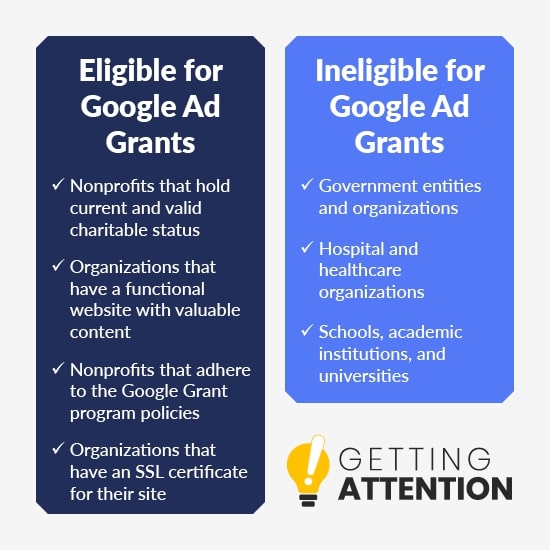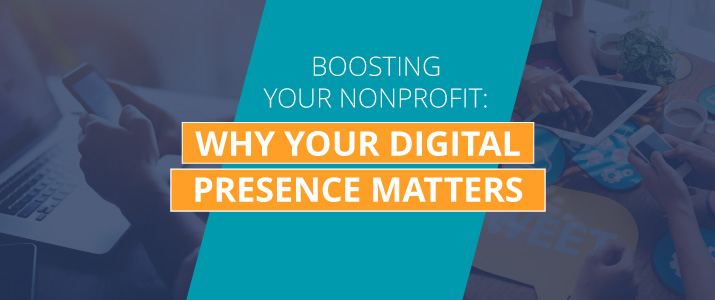From email to your website, your nonprofit’s digital presence spans multiple communication channels, each with its own unwritten rules for success. Managing several of these channels can easily monopolize your marketing team’s time and resources. As a result, nonprofits often consider cutting back on their online marketing efforts if they do not see immediate results.
While allocating marketing resources to various offline promotional strategies is perfectly fine, abandoning your nonprofit’s digital outreach is almost always a mistake. Some types of nonprofits, like grantmaking foundations, may choose to forego a website, but for most charitable organizations, establishing an online presence can greatly enhance their impact.
To help improve your nonprofit advertising and online outreach, this guide will explore why your digital presence matters and how you can maximize these benefits.
More marketing opportunities
As your nonprofit expands its online presence, you will access more marketing opportunities, allowing you to raise awareness and attract more supporters.
Some opportunities will emerge as your team becomes more familiar with managing your digital presence and invests in new tools. For example, nonprofits with technical expertise or that work with technology consultants may create optimized online spaces for donors that make giving easy and teach supporters about their nonprofit through interactive content.
Other opportunities will come as your nonprofit becomes well-established online. A few examples of these are:
- Social media ads. Your nonprofit can participate in paid social media advertising almost immediately after joining a social media site. After you’ve created an account, ensure your profile and other relevant pages are set up. This provides prospective supporters who click on your ads or research your organization with evidence that your nonprofit is active and trustworthy.
- Influencer marketing. Online influencers can connect your nonprofit with new audiences, and some influencers may even be interested in hosting fundraisers for your cause. Like with any partnership, search for influencers most likely to support you based on their interests and past engagement with nonprofits.
- Supporter fundraisers. Dedicated supporters may want to fundraise on your behalf. When launching a peer-to-peer campaign, consider how you can leverage your nonprofit’s social media presence. For example, Facebook offers Facebook Fundraisers, which allow anyone to launch a fundraiser for a nonprofit. If your nonprofit has an active Facebook account, you can interact with and promote these fundraisers, boosting contributions and solidifying your relationships with the supporters who run them.
When exploring marketing opportunities, do your research first and determine what will help your nonprofit meet its goals. For example, if you want to spread awareness of your cause, it may be beneficial to partner with influencers whose communities span a range of interests. In contrast, if you want to promote your services to potential beneficiaries, purchasing social media ads and joining groups for your local community may be more effective.
Whatever options you choose, however, ensure you have a way to track your progress and work toward improvement. For instance, with Facebook ads, you’ll want to track key performance indicators to ensure you’re getting the results you’re seeking.
Proven authority, relevance, and trustworthiness
Prospective supporters are likely to look up your nonprofit before donating. Along with helping them to learn more about your cause, this research also reassures them that your organization is a trustworthy, legitimate nonprofit. Maintaining an active digital presence ensures this is the reaction your supporters will have.
A few ways you can use your online presence to build trust with supporters include:
- Posting regularly. Nonprofits that regularly post unique, original content are more likely to be viewed as dynamic, active, and knowledgeable. When opening new social media accounts, make a posting schedule to ensure you’re regularly active. Share posts about your recent projects, campaigns, and events, and include links to important resources on your website like your donation page or your blog posts.
- Ensuring your content meets modern design standards. Outdated website designs may make supporters assume your nonprofit does not have modern security protections. Avoid this by ensuring your website has a sleek and fresh feel backed by user-friendly functionality. Also ensure that your web design is optimized for mobile devices. This is especially important given that 15% of American adults only access the internet from their smartphones.
- Interacting with supporters. Digital communication channels, especially social media, give supporters a direct line to your nonprofit. Double the Donation’s guide to nonprofit marketing recommends using this opportunity to interact with supporters by responding to their comments and messages and gathering feedback on their experiences with your nonprofit.
If your nonprofit needs help designing its website or bringing its marketing strategy into the modern era, consider working with a nonprofit consultant. Website development consultants can redesign your website or build a new one from scratch, while marketing consultants can provide advice on current marketing and design trends.
Increased website traffic
Nonprofits with an active digital presence attract online interest, causing an increased number of potential supporters to visit their websites. While not all of these prospects will convert, those that do can provide a valuable revenue stream, and some may even become long-term donors after a little stewardship.
In particular, online marketing is helpful in attracting completely new supporters to your nonprofit. Just like how social media ads connect your nonprofit to active social media users, search ads expand your reach to more Google users.
Search ads appear at the top of search engine results pages when a user enters a query with keywords related to your nonprofit. This approach allows you to advertise on Google, which is the most popular search engine with approximately 90% of the market share. Best of all, many nonprofits can do so for free with the Google Ad Grant.
The Google Ad Grants program provides participating nonprofits with $10,000 in monthly ad credits, allowing them to create Google Ads for free. To get started with this program, check your nonprofit’s eligibility. Getting Attention’s guide to applying for the Google Ad Grant provides this helpful chart for checking if your nonprofit qualifies:

If your nonprofit is a healthcare organization or educational institution, the fundraising branch of your organization may still be able to apply. After verifying your eligibility, take these steps to apply for the Google Ad Grant:
- Register for Google for Nonprofits. Your nonprofit will first need to apply for a Google for Nonprofits account, which should be granted if you meet the previous eligibility criteria. If accepted, your nonprofit will receive access to a variety of Google products for free, which may be worth it even if you are not interested in pursuing the Google Ad Grant.
- Submit your nonprofit for verification. Through your Google for Nonprofit account, submit your nonprofit for verification to Google’s technology partner, Percent. This process will be handled through your Google account, and there is no need to contact Percent directly.
- Fill out and submit your application. Once verified, you can fill out an application for the Google Ad Grant. It will ask basic questions about your nonprofit, such as what your mission is and what you hope to accomplish with the Google Ad Grant. Google will assess your application and your website to ensure it is high-quality.
If accepted into the Google Ad Grant program, you will receive free funding to spend on creating Google Ads. Research keywords your audience will likely search for, and create ads targeting those terms. Monitor your ads’ results to maintain your account and adjust ad copy and keyword targets to continue driving traffic to your website.
Your nonprofit’s digital presence is an investment in your long-term marketing potential. Supporters interested in causes like yours can stumble upon your content, those debating whether to donate can find more information about your cause, and active supporters can continually engage with your organization.

